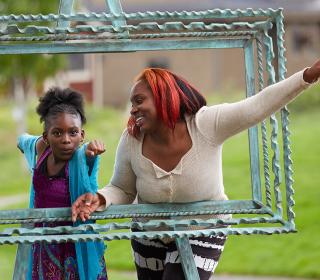
Modern Day Silencing of Women of Color
Tech industry
A recent report indicated only 24 percent of women work in STEM careers. Of that, about 4 percent include black and Latinx women. One reason is the way in which white men continue to gatekeep entry into the STEM pipeline. We indulge in endless conversations about why so few women of color are entering STEM fields and occupations, without ever assessing all the negative messages girls receive about how hard math, physics, and chemistry is, how there are so few in the field to mentor them, and how science is not welcoming to them. Our challenge is to stop talking and start ensuring the presence of women of color in every role tech has to offer.
POLITICAL ARENA
The lack of women in any given dialogue is typically not perceived as a loss. That is how male politicians can and do decide public policy which affects women and girls disproportionately without ever having a female present at the table. We have seen black women of elected office maligned and mocked as if what they do say is irrelevant and simply noise. Witness the current administration's threats and disdain for Congresswoman Maxine Waters; the sustained efforts to depict Florida Congressperson Frederica Wilson a liar, meddler, and "empty barrel" as she stood up for the rights of a widow of a slain black solider. California Senator Kamala Harris was interrupted and cut-off by white male colleagues during Senate hearings as well as Congresswoman Pramila Jayapal who was referred to as "young woman" by a white male colleague during a hearing. And Carmen Yulin Cruz, Mayor of Puerto Rico's capital San Juan, was relentlessly castigated by president Trump for her advocacy for Puerto Ricans in light of the devastation left by Hurricane Maria.
Trafficking - MAIL ORDER BRIDES
Seattle has its own history with the sexualization and trafficking of women of color by white men, including 19th and early 20th century brothels "specializing" in Asian, Native American and black women. In modern times, trafficking plays out in many ways including "mail-order brides". Our stereotypical thought of "mail-order brides" conjures images of quiet, passive women, happy to escape their desperate lives and be married to strong white men. However, the reality in so many instances was and is one of oppressive control and secret violence. An example of this is the 1995 shooting at the downtown Seattle Superior Court of a pregnant Filipina woman, Susana Remerata Blackwell, and two Filipina supporters shot to death by her husband as she waited to enter the courtroom in her divorce proceedings against him.

LATINX WOMEN
The separation of Latinx mothers from their children while seeking asylum and refuge at the U.S. border is only the most recent example of quieting women who speak up for themselves and name what they need. Latinx women are some of the lowest paid members of the U.S. workforce. Latinx women who work as janitors or on farms have long been targets of sexual assault; many of their accusations against major corporations have gone unheard. On daily basis, Latinx women are subjected to harassment and oppression due to assumptions about their heritage, their English language skills, and their work capabilities.
NATIVE AMERICAN WOMEN
Five hundred years of cultural genocide means that Native peoples as a whole have embedded generational trauma. We have seen a historic Native American woman, Pocahontas, sexualized and her true story turned into a cartoon by Disney. Further, her name is invoked to diminish and make cheap fun of a sitting female U.S. Senator. Native American women are 84 percent more likely of all women to experience violence in their lifetime. Some studies show that Native women are murdered at 10 times the national average, in some instances by white predators. The Missing and Murdered Indigenous Women movement raises awareness of the many forms of violence perpetrated against Native women. Native American women also suffer pay disparity at a higher rate than white women.

African American WOMEN
Women of color get different messages about the worth of their voices and the consequences of speaking out. African American women also carry generational trauma from the effects of slavery, Jim Crow, segregation, and everyday oppression. African American's achievements are constantly undermined. As an example, African American women's beauty does not meet societal standards, yet African American women's hairstyles and fashion sense are constantly being appropriated without acknowledgment.
We know that African American women have to work eight months into the following year to be paid as much as white men. The message that African American women's contributions to American society are not valued begins early. For instance, starting as early as kindergarten and first grade, African American girls in school are punished for being too chatty, too loud, or too questioning. Their curiosity is seen as threatening, as disruption of the preferred [white] ideal of young girls as quiet, submissive, and well-behaved. African American girls are often seen as not bright or smart enough to be worth mentoring through their school years. In these ways, African American girls receive confusing messages about whether education - and school - are welcoming or accessible to them.
#METOO
The many aspects of violence directed against women of color have not diminished over the centuries. A significant way to silence women, whether in public spaces, at work, or in private, is to use sexual harassment and assault. If women do report or speak out against their attackers and predators, society ensures they will not be believed, or that they must endlessly prove their worthiness to make the claim of harm. In any event, women of color are expected to tolerate a level of violence against their persons that has been normalized in conscious and unconscious ways.
The #MeToo movement created a worldwide cultural shift. Originally founded by Tarana Burke, an African American woman, the movement was created to give women and men survivors of sexual harm a voice to speak out against sexual violence. With more women speaking out against perpetrators and with some of the accused actually being held accountable, women's voices are beginning to be heard.
GETTING IN THE POWER SEAT
This year the U.S. saw a record 472 female-identifying persons running for elected positions. There is also more woman of color, including immigrants, running than in previous electoral years. For example, in the state of Alabama alone, 18 African American women are running for elected office. Many of the women running are young and single.
Take action
Ways to support the voices of women of color include:
- Always ensure that black and brown women are in the room and at the table.
- Women of color should lead conversations, particularly about issues and concerns that affect them most.
- Listen to the ideas, comments, and critiques made by women of color.
- Do not interrupt, minimize or dismiss their voices.
- Use white privilege to advocate for women of color whose voices are being ignored or lost in the shuffle; however, do not speak for them.
- Believe women of color when they tell you about the indignities, oppression, and violence they have suffered.
- Work to implement the ideas and solutions of women of color.
- Be a humble, thoughtful partner to the work of women of color.

A former prosecutor and trial lawyer, her work has long explored racial equity and social justice issues, including the prevention of violence against women and children, the pervasive nature of state-sanctioned violence against people of color, societal and cultural roles for women, and leadership development for girls and women.
We share the stories of our program participants, programs, and staff, as well as news about the agency and what’s happening in our King and Snohomish community.

